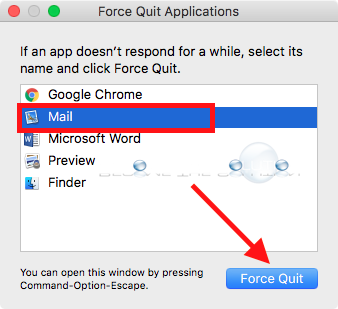

OS X internally has a lot of optimisations like App Nap which help to keep background apps' effect on system resources to a minimum: In overall, to answer your question about how it hits system efficiency, memory and battery: OS X handles it properly and does as much as possible to optimize efficiency, unless the Application itself is written poorly. There are a bunch of those utilities that close applications when you click the the red close button.
#HOW TO FORCE CLOSE ON MAC OS WINDOWS#
You may also want to overload the default behaviour, and to make it like in Windows OS, but you need to use separate utilities (like RedQuits). For unresponsive apps: Force Quit ( ⌘ cmd+ ⌥ alt+ esc).Using Activity Monitor: Applications> Utilities> Activity Monitor.At the bottom of this list is the Quit option. Using contextual menu (or application's menu): Go to the Dock at the bottom of the screen and find the icon for the app, then right click (or ctrl+ click) to bring up the contextual menu.If you want to quit the app (release the memory, reduce CPU usage, etc) then there are several ways to do this: If you want to quit an app, click the app’s name in the menu bar, then choose Quit. When you close an app’s window, the window closes, but the app remains open. Here's more information from Apple's support pages: When you press X button in the window - you actually close the windows related to the app, but it does not quit. Hold down your power button (or the Touch ID button if your Mac has a Touch Bar) until the Apple logo appears on your screen.One of Mac's most confusing features is the red close button, which you think would shut down an application but often doesn't.

You might lose some of what you're currently working on, but it will shut down the app that's driving you crazy.

If you think the app is CPU-intensive, you can try clicking on the "% CPU" header, which may put the app at the top of the list. The list will be long, so you can click on the "Process Name" header to sort the list alphabetically for easier searching.

Click the Apple icon in the upper left corner and look for a choice that says "Force Quit" or.Again, there are several ways to do this: However, if the app is frozen or won't disappear, you need to force quit. Right-click the app icon in the menu bar and select "Exit" or….The first thing to do, of course, is to try to quit the application normally: If this happens to you (and it can happen often if you're playing the latest Monterey betas), it's time to quit the app. Apps on macOS generally behave well, but there are times when they can stop working or crash and slow down your entire Mac.


 0 kommentar(er)
0 kommentar(er)
